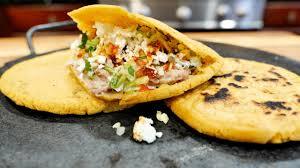Introduction
Gorditas, often translated as “little fatties,” are a quintessential element of Mexican cuisine, cherished for their hearty texture and flavorful versatility. These thick tortillas can be stuffed with a myriad of ingredients, making them a popular choice for both casual meals and festive occasions. This article delves into the origins, preparation techniques, cultural significance, and modern adaptations of gorditas, offering a detailed exploration of this beloved Mexican staple.
The Origins of Gorditas
Historical Background
Gorditas trace their roots back to ancient Mesoamerican civilizations, where corn was a central element of the diet. The indigenous peoples of Mexico, such as the Aztecs and Maya. Utilized corn to create a variety of dishes. The thick tortilla concept, a precursor to the modern gordita, was likely an extension of these ancient practices.
Spanish Influence and Evolution
When Spanish explorers arrived in Mexico in the 16th century. They introduced new ingredients and cooking methods. The fusion of indigenous corn-based foods with Spanish culinary practices led to the evolution of gorditas. The introduction of wheat flour by the Spanish expanded the gordita’s range, leading to the creation of flour-based varieties.
Ingredients and Preparation
Basic Ingredients
The fundamental components of gorditas include masa (corn dough) flour dough, and various fillings. Here’s a breakdown of the key ingredients:
Masa (Corn Dough):
Made from nixtamalized corn, masa is the cornerstone of traditional gorditas. Nixtamalization, a process involving soaking corn in limewater, enhances the dough’s flavor and nutritional value.
Flour Dough:
For flour gorditas, a mixture of flour, baking powder, salt, and fat (usually lard or vegetable shortening) is used. This dough is softer and results in a different texture compared to corn gorditas.
Fillings:
Fillings can range from traditional meats like carnitas and barbacoa to modern options such as grilled vegetables and international flavors.
Traditional Preparation Methods
Making Corn Gorditas
Prepare the Masa:
Start with pre-made masa or make your own by mixing nixtamalized corn with water and salt.
Shape the Gorditas:
Form the masa into thick, round discs about 1/2 to 1 inch thick.
Cook on a Comal:
Heat a Comal or griddle over medium heat. Cook the gorditas for about 3-4 minutes on each side, or until they develop a golden brown color and a slight puffiness.
Making Flour Gorditas
Prepare the Dough:
Mix flour, baking powder, salt, and fat until the mixture resembles coarse crumbs. Add water gradually to form a soft dough.
Shape the Gorditas:
Divide the dough into balls and flatten them into thick discs.
Cook on a Griddle:
Heat a griddle or non-stick pan over medium heat. Cook the discs for 2-3 minutes on each side, or until golden brown and cooked through.
Popular Fillings and Toppings
Traditional Fillings
Carnitas:
Slow-cooked pork shoulder, seasoned with a blend of spices, and often served with onions, cilantro, and salsa.
Barbacoa:
Beef that has been marinated and slow-cooked, resulting in tender, flavorful meat that is shredded and used as a filling.
Cecina: Thinly sliced, salted, and dried beef that is pan-fried and used as a hearty filling.
Modern Fillings
Chicken Mole:
A rich, complex sauce made from chilies, chocolate, and spices, served with tender chicken.
Vegetarian Options:
Roasted vegetables, cheese, and beans are popular choices for those seeking a meat-free option.
Fusion Fillings:
Ingredients like teriyaki chicken, Mediterranean lamb, or spicy kimchi reflect the gordita’s adaptability to global flavors.
Serving Suggestions
Traditional Accompaniments
Salsa:
Fresh or cooked salsa made from tomatoes, chilies, onions, and cilantro enhances the flavor of gorditas.
Guacamole:
A creamy avocado dip mixed with lime juice and cilantro provides a refreshing contrast.
Mexican Crema:
A tangy, creamy topping that complements the gorditas’ rich fillings.
Creative Ideas
Sriracha Aioli:
A spicy mayo-based sauce for an added kick.
Pickled Vegetables:
Pickled jalapeños, radishes, or onions add a tangy crunch.
Cheese and Herbs:
Crumbled queso fresco or shredded cheddar and fresh herbs for a burst of flavor.
Gorditas in Mexican Culture
Cultural Significance
it hold a special place in Mexican culture, often enjoyed as a comforting meal or a festive treat. They are commonly found at family gatherings, street food stalls, and local markets. The preparation and enjoyment of gorditas often reflect regional traditions and family recipes, making them a symbol of cultural heritage.
Regional Variations
Different regions in Mexico offer unique takes on gorditas:
Northern Mexico:
In areas like Nuevo León and Coahuila, they are often stuffed with meats like machaca (dried, shredded beef).
Central Mexico:
Gorditas from Mexico City might include a variety of traditional fillings and are often served with spicy salsas.
Southern Mexico:
In Oaxaca and surrounding states, it might be filled with local specialties like tlayudas or quesillo (Oaxacan cheese).

Gorditas Beyond Mexico
In the United States
they have gained popularity in the U.S. through Mexican restaurants, food trucks, and even fusion cuisine. They are often featured on menus alongside tacos, burritos, and enchiladas, providing a unique option for those exploring Mexican flavors.
In Latin America
While gorditas are predominantly a Mexican dish, similar thick tortillas can be found throughout Latin America. Each with its regional variations. In some countries, they are known by different names and might be served with local ingredients and flavors.
Nutritional Aspects
Corn Gorditas
Corn offer several nutritional benefits. Corn is a good source of fiber, vitamins (especially B vitamins), and minerals such as. Magnesium and potassium. The nixtamalization process also increases the availability of certain nutrients, including calcium.
Flour Gorditas
Flour tend to be higher in fat and calories compared to their corn counterparts. However, they can still be part of a balanced diet when enjoyed in moderation. Opting for whole wheat flour can enhance the nutritional value of flour gorditas.
Conclusion
Gorditas are a delightful and versatile part of Mexican cuisine, with a rich history and a wide range of flavors and fillings. From their ancient origins to their modern adaptations, gorditas continue to be a beloved comfort food that brings people together. By experimenting with different ingredients and cooking methods, you can enjoy this Mexican classic in countless delicious ways. Embrace the gordita and explore the diverse culinary possibilities it offers. Celebrating its place in both traditional and contemporary cuisine.


